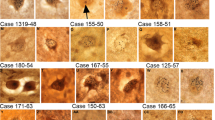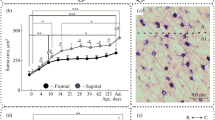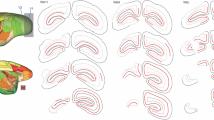Summary
Application of light and electron microscopic techniques to the superior colliculus of the normal rat shows that a number of neurons die within the first week after birth. Cells in the earliest recognizable stages of degeneration are characterized by an overall increase in electron density and dilation of the intracellular cisternae, although there are only minimal changes in the chromatin pattern of the nucleus. Synapses are found on these cells. A second type of degenerating cell, with more striking changes in the nucleus, also appears in the tissue but very infrequently. In later stages of degeneration, cells are reduced to a condensed chromatin mass surrounded by disrupted fragments of the rest of the cell. This ‘cellular debris’ is found within glial cytoplasm. The majority of these debris profiles appear in the first postnatal week and are usually most abundant in the caudal third compared to either the rostral or middle thirds of the colliculus. The results suggest that the mechanisms controlling neuron number in the superior colliculus are operative in the postnatal rat but argue against a simple relationship between the survival of a particular neuron and the total number of optic connections that neuron has received.
Similar content being viewed by others
References
Alley, K. E. (1974) Morphogenesis of the trigeminal mesencephalic nucleus in the hamster; cytogenesis and neuron death.Journal of Embryology and Experimental Morphology 31, 99–121.
Arees, E. A. &Aström, L. E. (1977) Cell death in the optic tectum of the developing rat.Anatomy and Embryology 151, 29–34.
Cammermeyer, J. (1978) Is the solitary dark neuron a manifestation of postmortem trauma to the brain inadequately fixed by perfusion?Histochemistry 56, 97–115.
Canting, D. &Daneo, L. S. (1972) Cell death in the developing chick optic tectum.Brain Research 38, 13–25.
Chu-Wang, I. W. &Oppenheim, R. W. (1978) Cell death of motoneurons in the chick embryo spinal cord. I. A light and electron microscopic study of naturally occurring and induced cell loss during development.Journal of Comparative Neurology 177, 33–58.
Cowan, W. M. (1973) Neuronal death as a regulative mechanism in the control of cell number in the nervous system. InDevelopment and Aging in the Nervous System (edited byRockstein, M.), pp. 19–41. New York: Academic Press.
Cowan, W. M. (1978) Aspects of neuronal development. InInternational Review of Physiology, Neurophysiology III, Vol. 17 (edited byPorter, R.), pp. 149–191. Baltimore: University Park Press.
Cunningham, T. J., Murray, M. &Huddleston, C. (1977) Hypertrophy and hyperplasia in the rat visual system after posterior decortication at birth.Anatomical Record 187, 561 (abstract).
Cunningham, T. J., Murray, M. &Huddleston, C. (1979) Modification of neuron numbers in the visual system of the rat.Journal of Comparative Neurology 184, 425–34.
Flanagan, A. E. H. (1969) Differentiation and degeneration in the motor horn of the foetal mouse.Journal of Morphology 129, 281–306.
Giordano, D. L. &Cunningham, T. J. (1978) Naturally occurring neuron death in the superior colliculus of the postnatal rat.Anatomical Record 190, 402–3 (abstract).
Hamburger, V. (1975) Cell death in the development of the lateral motor column of the chick embryo.Journal of Comparative Neurology 160, 535–46.
Hughes, A. (1961) Cell degeneration in the larval ventral horn ofXenopus laevis.Journal of Embryology and Experimental Morphology 9, 269–84.
Hughes, A. (1973) The development of dorsal root ganglia and ventral horns in the opossum. A quantitative study.Journal of Embryology and Experimental Morphology 30, 359–76.
Jacobson, M. (1978)Developmental Neurobiology. 2nd edn, pp. 281–285. New York: Plenum Press.
Kallen, B. (1965) Degeneration and regeneration in the vertebrate central nervous system during embryogenesis.Progress in Brain Research 14, 77–96.
Konigsmark, B. W. (1970) Methods for counting neurons. InContemporary Research Methods in Neuroanatomy (edited byNauta, W. J. H. andEbbesson, S. O. E.), pp. 315–340. New York: Springer-Verlag.
Ling, E. A., Paterson, J. A., Privat, A., Mori, S. &Leblond, C. P. (1973) Investigation of glial cells in semi-thin sections. I. Identification of glial cells in the brain of young rats.Journal of Comparative Neurology 149, 43–72.
Lund, R. D. &Lund, J. S. (1972) Development of synaptic patterns in the superior colliculus of the rat.Brain Research 42, 1–20.
Lund, R. D. &Bunt, A. H. (1976) Prenatal development of central optic pathways in albino rats.Journal of Comparative Neurology 165, 247–64.
Peters, A., Palay, S. L. &Webster, H. deF. (1976)The Fine Structure of the Nervous System. The Neurons and Supporting Cells, pp. 11–65. Philadelphia: Saunders.
Pilar, G. &Landmesser, L. (1976) Ultrastructural differences during embryonic cell death in normal and peripherally deprived ciliary ganglia.Journal of Cell Biology 68, 339–56.
Prestige, M. C. (1970) Differentiation, degeneration and the role of the periphery: quantitative considerations. InThe Neurosciences (edited bySchmidt, F. O.), pp. 73–82. New York: Rockefeller University Press.
Reynolds, E. S. (1963) The use of lead citrate at high pH as an electron-opaque stain in electron microscopy.Journal of Cell Biology 17, 208–12.
Romanes, G. J. (1946) Motor localization and the effects of nerve injury on the vental horn cells of the spinal cord.Journal of Anatomy 80, 117–31.
Author information
Authors and Affiliations
Rights and permissions
About this article
Cite this article
Giordano, D.L., Murray, M. & Cunningham, T.J. Naturally occurring neuron death in the optic layers of superior colliculus of the postnatal rat. J Neurocytol 9, 603–614 (1980). https://doi.org/10.1007/BF01205028
Received:
Revised:
Accepted:
Issue Date:
DOI: https://doi.org/10.1007/BF01205028




